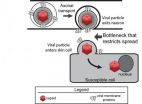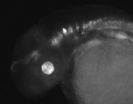(Press-News.org)
VIDEO:
Princeton University research suggests that a common strain of herpes virus causes cold sores with only one or two viral particles, resulting in a bottleneck in which the infection is...
Click here for more information.
New research suggests that just one or two individual herpes virus particles attack a skin cell in the first stage of an outbreak, resulting in a bottleneck in which the infection may be vulnerable to medical treatment.
Unlike most viruses that spread to new cells by bombarding them with millions of particles, herpes simplex virus type 1 (HSV-1) — a virus that causes cold sores and genital lesions — requires just one or two viral particles to infect a skin cell in the first stage of cold sore formation, Princeton University researchers reported this month in the Proceedings of the National Academy of Sciences.
"The fact that just one or two virus particles are involved is surprising because these viruses can replicate themselves hundreds of times in a single cell," said Matthew Taylor, first author on the study and a postdoctoral researcher in the laboratory of Lynn Enquist, the Henry L. Hillman Professor in Molecular Biology and the Princeton Neuroscience Institute.
The bottleneck occurs when HSV-1 particles, which can lie dormant in the cells of the nervous system for decades after initial infection, awaken and invade a nearby skin cell, the first stage in sore formation. Once inside the skin cell, a single viral particle multiplies and spreads millions of copies to nearby skin cells, creating a visible lesion or "cold sore." The virus can then spread to new individuals through skin-to-skin contact.
This restriction to one or two particles limits the genetic diversity of the virus that spreads to the next individual, Enquist said. This puts the virus at a disadvantage, he said, because having a variety of distinct genomes enhances the overall chances of the virus surviving and spreading. A well-known example of a virus that relies on genetic diversity to thrive is HIV, which involves large numbers of viral particles with distinct genomes.
In the case of herpes viruses, Enquist said: "The number of different genomes that infect the cell is remarkably low, so any mutations that weaken the virus are unlikely to survive. Only the most fit viral particles will survive and replicate in the epithelial [skin] cells, and be available to transmit to the next individual."
Although bottlenecks can ensure that only the most fit viruses are transmitted to the next individual, they also can be points at which the infection is more susceptible to immune system responses and drug treatments, according to Taylor. He and Enquist worked with co-author Oren Kobiler, a former Princeton postdoctoral researcher now at Tel Aviv University.
The researchers' findings suggest that other viruses related to HSV-1 — known as alpha-herpes viruses — may have similar bottlenecks, Taylor said, including herpes simplex viruses type 2, which causes cold sores and genital lesions, and varicella zoster virus, which causes chicken pox and shingles. It remains to be determined if this bottleneck exists for other viruses that spread from infected neurons, such as poliovirus and the West Nile virus, Taylor said.
Julie Pfeiffer, an associate professor of microbiology at the University of Texas Southwestern Medical Center, said the Princeton research is the first to tally how many viral particles are involved in HSV-1 infection — and reveal that as the virus' weak point.
"This work changes the way that we think about herpes virus spread," said Pfeiffer, who is familiar with the study but had no role in it. "This study demonstrated that these neuron-to-epithelial cell viral-transmission events are surprisingly efficient, but they are initiated by a very small number of viruses. This work has interesting implications for herpesvirus transmission and evolution."
To determine the number of virus particles that infect the skin cell, the researchers constructed three genetically unique viral genomes labeled with either red, green or blue fluorescent tags, and then infected cells with the particles and analyzed them for the presence of the three colors. They counted the number of cells containing one, two or all three colors and used statistical analysis to determine the number of unique viral genomes expressed in each cell. The method, which was originally developed by Kobiler, Enquist and colleagues in Princeton's mathematics department and initially published in 2010 in Nature Communications, revealed that most skin cells express less than two viral genomes on average.
Taylor then filmed individual virus particles of pseudorabies virus, a model alpha-herpes virus that infects animals, as the particles exited neurons and entered skin cells. He found that the bottleneck limiting infection to one or two particles exists for pseudorabies virus as well.
As shown in the video of the process, viral particles, genetically altered to glow red, travel down long extensions of the neuron cell body called axons.
The video reveals a handful of viral particles exiting an axon but only one particle entering a nearby epithelial cell. Once inside, the virus particle replicates and creates millions of particles that fill up the cell, turning it red in color. These viral particles later exit the infected cell and attack surrounding epithelial cells.
"It is really amazing to see this happening in living cells," Taylor said.
INFORMATION:
The paper, "Alphaherpesvirus axon-to-cell spread involves limited virion transmission," was published Oct. 16 in the Proceedings of the National Academy of Sciences. The work was supported by the National Institutes of Health and the American Cancer Society.
Princeton researchers identify unexpected bottleneck in the spread of herpes simplex virus
2012-11-05
ELSE PRESS RELEASES FROM THIS DATE:
New research suggests standardized booster seat laws could save lives of children
2012-11-05
Boston, Mass, Nov. 5, 2012— A new study by researchers in Boston Children's Hospital's Division of Emergency Medicine indicates that a nationwide standard on booster seat laws for children 4 feet 9 inches and shorter, or up to 8 years old, would save lives. The findings were published online Nov. 5, 2012, in the journal Pediatrics.
Boston Children's researchers reviewed data from Fatality Analytic Reporting System, analyzing child deaths in motor vehicle accidents, looking specifically at whether the crash and resulting deaths or injuries took place in a state with or ...
Computers 'taught' to ID regulating gene sequences
2012-11-05
Johns Hopkins researchers have succeeded in teaching computers how to identify commonalities in DNA sequences known to regulate gene activity, and to then use those commonalities to predict other regulatory regions throughout the genome. The tool is expected to help scientists better understand disease risk and cell development.
The work was reported in two recent papers in Genome Research, published online on July 3 and Sept. 27.
"Our goal is to understand how regulatory information is encrypted and to learn which sequence variations contribute to medical risks," says ...
Superstorm animation
2012-11-05
A computer animation produced by University of Delaware researchers shows the explosive development of Hurricane Sandy, the superstorm and its unusual track. View the animation on the University's UDaily website at http://www.udel.edu/udaily/2013/nov/animation110212.html
Matt Shatley, computer research specialist in UD's College of Earth, Ocean, and Environment (CEOE), assembled the animation by digitally stitching together about 800 infrared images taken by GOES, the Geostationary Operational Environmental Satellite, which keeps a continuous eye on the continental United ...
Japanese family members less likely than others to give CPR for cardiac arrest
2012-11-05
Family members didn't give CPR for cardiac arrests as often as passers-by or friends in a Japanese study presented at the American Heart Association's Scientific Sessions 2012.
Cardiac arrest is the sudden loss of heart function, typically resulting from an abnormal heart rhythm that causes the heart to quiver erratically and stop pumping blood. According to the American Heart Association, effective bystander CPR provided immediately after sudden cardiac arrest can double or triple a victim's chance of survival.
In a review of 547,218 cardiac arrests occurring in 2005-09, ...
New device could allow your heartbeat to power pacemaker
2012-11-05
An experimental device converted energy from a beating heart to provide enough electricity to power a pacemaker, in a study presented at the American Heart Association's Scientific Sessions 2012.
The findings suggest that patients could power their pacemakers — eliminating the need for replacements when batteries are spent.
In a preliminary study, researchers tested an energy-harvesting device that uses piezoelectricity — electrical charge generated from motion. The approach is a promising technological solution for pacemakers, because they require only small amounts ...
Heart disease map of England highlights growing social inequality in older ages
2012-11-05
A study estimating the death rate from heart and circulatory disease in each electoral ward in England has found that despite considerable improvements since the 1980s, the difference between the wealthiest and poorest communities has widened for people over 65.
Mortality from heart and circulatory disease – the leading cause of death in the UK – declined in most places between 1982 and 2006, but for men and women aged 65 or older, the decline was smaller in the most deprived communities, resulting in a wider gap between rich and poor.
The authors, from Imperial College ...
Smallholder farmers need improved stake in Nile's development
2012-11-05
ADDIS ABABA (5 NOVEMBER 2012)—A new book finds that the Nile river, together with its associated tributaries and rainfall, could provide 11 countries—including a new country, South Sudan, and the drought-plagued countries of the Horn of Africa—with enough water to support a vibrant agriculture sector, but that the poor in the region who rely on the river for their food and incomes risk missing out on these benefits without effective and inclusive water management policies.
The Nile River Basin: Water, Agriculture, Governance and Livelihoods, published by the CGIAR Challenge ...
Cardiac bypass surgery superior to non-surgical procedure for adults with diabetes and heart disease
2012-11-05
Adults with diabetes and multi-vessel coronary heart disease who underwent cardiac bypass surgery had better overall heart-related outcomes than those who underwent an artery-opening procedure to improve blood flow to the heart muscle, according to the results from an international study. The research was supported by the National Heart, Lung, and Blood Institute (NHLBI), part of the National Institutes of Health.
The study compared the effectiveness of coronary artery bypass graft (CABG) surgery with a non-surgical procedure known as percutaneous coronary intervention ...
Penn Medicine contest maps 1,400 lifesaving AEDs via crowdsourcing contest fueled by smart phones
2012-11-05
LOS ANGELES – A crowdsourcing contest that sent hundreds of Philadelphians to locate and catalog the locations of AEDs throughout the nation's fifth largest city led to the identification of more than 1,400 automated external defibrillators in public places, according to a study from researchers from the Perelman School of Medicine at the University of Pennsylvania that will be presented today at the American Heart Association's Scientific Sessions 2012 (Abstract #17478). The efforts of these "citizen scientists" are expected to help provide crucial data to ensure quick ...
Families 'Play Nice' in Alpha Colony, Which Combines Competative and Cooperative Play
2012-11-05
DreamQuest Games has luanched its Kickstarter campaign for all new family-friendly game, Alpha Colony. What makes the game wholly unique is it's interesting balance of competitive and cooperative play. The goal of the game is to build the most prosperous prospector on a new and distant colony. But in Alpha Colony, it takes more than being the best to win. If the colony doesn't cooperate to thrive as a whole, everyone loses.
Alpha Colony's emphasis on cooperation makes it a game the whole family can enjoy. While creating an interesting dynamic for stronger players, it ...



